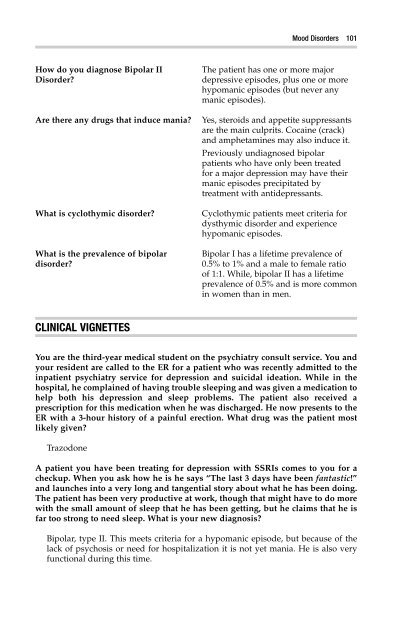Behavioral Science
Create successful ePaper yourself
Turn your PDF publications into a flip-book with our unique Google optimized e-Paper software.
Mood Disorders 99<br />
What is electroconvulsive therapy<br />
(ECT)?<br />
When is ECT used?<br />
What are the main side effects<br />
of ECT?<br />
What are the DSM-IV-TR diagnostic<br />
criteria for a Manic Episode?<br />
What is the difference between<br />
hypomania and mania?<br />
What is a mixed episode?<br />
How do you diagnose Bipolar I<br />
Disorder?<br />
It is the induction of a generalized<br />
seizure by applying electric currents<br />
to the brain.<br />
It is mainly indicated for patients with<br />
refractory or psychotic depression, but<br />
it can also be used for the treatment of<br />
mania.<br />
Short-term memory loss<br />
A 1-week period of elevated,<br />
expansive, or irritable mood (or less<br />
if hospitalized) with at least three<br />
of the following (four if mood<br />
irritable):<br />
Grandiosity or inflated self-esteem<br />
Decreased need for sleep<br />
More talkative<br />
Flight of ideas/racing thoughts<br />
Distractibility<br />
Increased goal-directed activity<br />
Involvement in pleasurable and risky<br />
activities<br />
Hypomanic episodes last 4 days or<br />
more and do not require hospitalization<br />
or involve psychotic features. In<br />
general, hypomania is less severe<br />
than mania.<br />
A 1-week or longer period in which<br />
criteria for both manic and major<br />
depressive episodes are met.<br />
The patient has one or more manic or<br />
mixed episodes. Usually there is also a<br />
depressive episode, but this is not<br />
required for the diagnosis.



